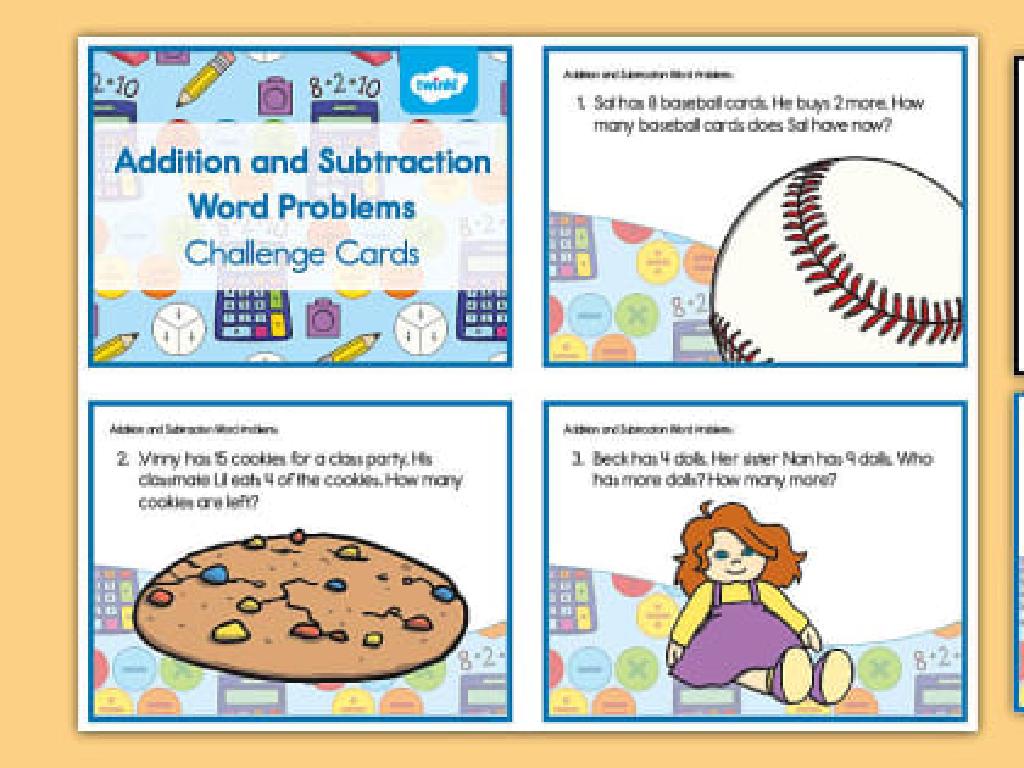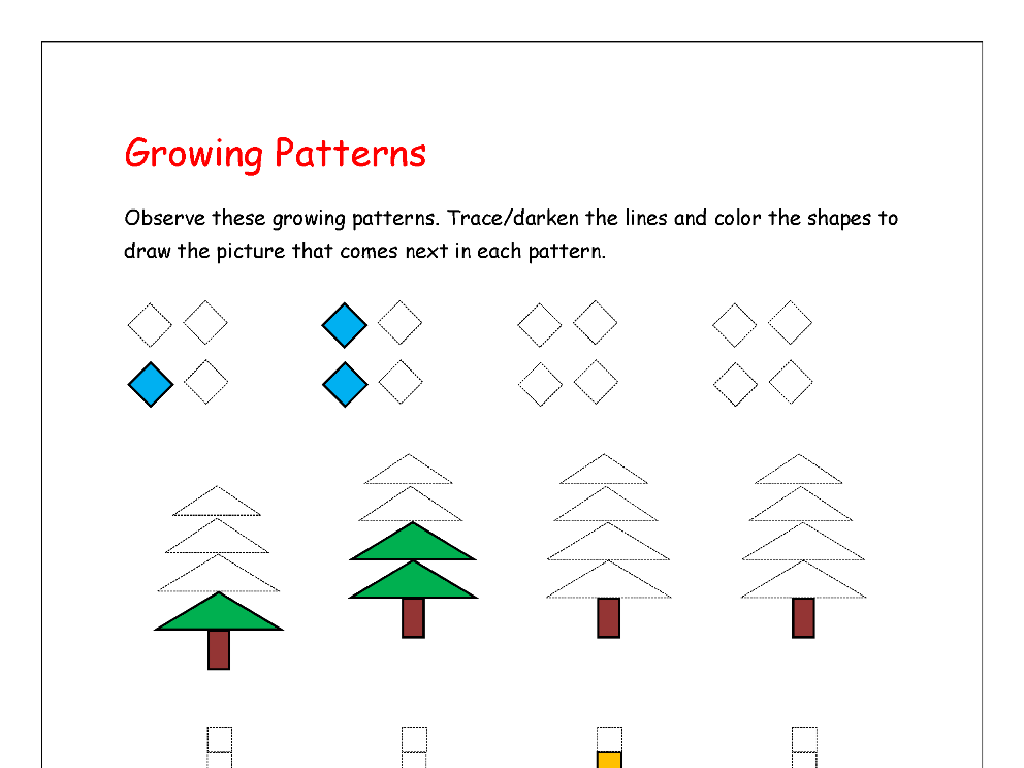Decompose Fractions Into Unit Fractions
Subject: Math
Grade: Third grade
Topic: Understand Fractions
Please LOG IN to download the presentation. Access is available to registered users only.
View More Content
Welcome to Fractions!
– Fractions represent parts of a whole
– Like a pizza sliced into 4 pieces, each piece is a fraction of the pizza
– A fraction has a numerator and denominator
– The top number (numerator) shows how many parts we have. The bottom number (denominator) shows how many equal parts the whole is divided into
– Fractions are used in daily life
– We use fractions when cooking, in stores, and to divide things fairly
– Learning fractions helps with problem-solving
|
This slide introduces students to the concept of fractions, emphasizing their role as representations of parts of a whole. Use relatable examples like slices of pizza to illustrate the idea of a fraction. Explain the terms numerator and denominator, ensuring students understand these are parts of a fraction. Highlight the practicality of fractions in everyday life, such as in cooking or shopping, to show relevance. Emphasize that understanding fractions is a key skill that aids in problem-solving and is foundational for more advanced math concepts.
Understanding Unit Fractions
– Every fraction is a combo of unit fractions
– Think of a pizza cut into equal slices. Each slice is a unit fraction of the whole pizza.
– Unit fraction: numerator is 1
– It’s like having one piece of something that’s cut into equal parts.
– Examples: 1/2, 1/3, 1/4
– These are all unit fractions because they each represent one part of a whole divided into equal parts.
|
This slide introduces the concept of unit fractions, which are the building blocks of all other fractions. Emphasize that a unit fraction is a fraction where the numerator (the top number) is always 1, indicating a single part of a whole that is divided into equal parts. Use relatable examples like slices of pizza or pieces of a chocolate bar to illustrate the concept. Encourage students to think of unit fractions as one piece of a divided object, and show them how every fraction is made up of unit fractions. This foundational understanding will help them decompose larger fractions into unit fractions in future lessons.
Decomposing Fractions into Unit Fractions
– What does decomposing mean?
– Fractions can be broken down
– Just like a toy made of blocks, we can take apart fractions
– Unit fractions are like fraction pieces
– Each piece is one part of the whole, like 1/4 is one piece of a pie
– Example: Breaking down 3/4
– 3/4 is made of three 1/4 pieces put together
|
This slide introduces the concept of decomposing fractions for third graders. Begin by explaining that ‘decomposing’ in math means breaking down numbers into parts. Emphasize that any fraction can be decomposed into unit fractions, which are fractions with a numerator of 1. Use visual aids like pie charts or fraction bars to show how 3/4 can be seen as three separate pieces of 1/4 each. Encourage students to think of other fractions they can decompose and to visualize the process using objects like pizza slices or chocolate bars.
Let’s Practice Decomposing Fractions!
– Decompose 2/3 into unit fractions
– 2/3 = 1/3 + 1/3
– Now, let’s decompose 5/6!
– 5/6 = 1/6 + 1/6 + 1/6 + 1/6 + 1/6
– Each piece has 1 as the numerator
– Understand unit fractions better
– Unit fractions make up other fractions
|
This slide is an interactive practice for students to understand how to decompose fractions into unit fractions. Start by explaining that decomposing means breaking down a fraction into smaller ‘unit fractions,’ where each fraction has a numerator of 1. Use visual aids like fraction circles or bars to show 2/3 and 5/6 being broken into smaller pieces. Each piece represents a unit fraction. Encourage students to think of other fractions they can decompose and to visualize the process. This activity will help solidify their understanding of fractions as composed of unit fractions and enhance their ability to work with fractions in various contexts.
Visualizing Fraction Decomposition
– Use shapes to understand fractions
– Picture a pizza cut into equal slices, each slice is a fraction of the whole.
– Shade to represent unit fractions
– If we color one slice, it shows 1 part of the whole, like 1/8 of a pizza.
– Group activity: Decompose shapes
– In groups, take a shape and divide it into equal parts, then express each part as a unit fraction.
– Discuss decomposition with peers
– Share how you broke down the shape into unit fractions and learn from others.
|
This slide introduces the concept of decomposing fractions using visual aids. Start by explaining that shapes can be divided into equal parts, which represent fractions of the whole. Demonstrate shading one part to illustrate a unit fraction. For the group activity, provide various shapes on paper for students to shade and decompose into unit fractions. Encourage discussion among peers to foster understanding of how whole shapes can be broken down into smaller, equal fractions. This hands-on activity will help solidify the concept of fraction decomposition through visual and collaborative learning.
Class Activity: Fraction Art Creation
– Create your own fraction art piece
– Use fraction strips for your picture
– Explain your fraction decomposition
– Break down the fractions used in your art
– Share your art with the class
|
This activity is designed to help students understand the concept of decomposing fractions by creating art with fraction strips. Students will use different fraction strips to create a picture, which will visually demonstrate how larger fractions can be broken down into smaller unit fractions. Encourage creativity and ensure that each student has a variety of fraction strips. After completing their art, students will share how they decomposed the fractions in their artwork with the class. This will reinforce their understanding and ability to explain the concept. Possible activities include creating animals, landscapes, or abstract designs. Ensure that students articulate the fractions used and how they combine to form whole numbers or other fractions.
Review: Decomposing Fractions
– Recap on fraction decomposition
– Breaking down fractions into smaller ‘unit fractions’.
– Understanding unit fractions
– Unit fractions have a numerator of 1, like 1/3 or 1/4.
– Explaining decomposition process
– Each fraction is a sum of unit fractions, e.g., 3/4 = 1/4 + 1/4 + 1/4.
– Open floor for questions
|
This slide is aimed at reviewing the concept of decomposing fractions into unit fractions. Start by asking the students to summarize what they’ve learned about fraction decomposition to reinforce their understanding. Then, move on to unit fractions, ensuring they grasp that these are fractions with a numerator of one. Next, explain the process of decomposing a fraction into a sum of unit fractions with examples. Finally, encourage students to ask questions to clarify any doubts, ensuring they’re comfortable with the concept before moving on. This interactive review will help solidify their understanding and prepare them for more complex fraction operations.
Homework Challenge: Fraction Decomposition
– Practice decomposing fractions
– Complete the provided worksheet
– Each fraction into unit fractions
– Break down fractions like 1/4 into 1/4 = 1/4
– Share your answers in class
|
This homework challenge is designed to reinforce the concept of decomposing fractions into unit fractions. Students are expected to take home their understanding of fractions and apply it to a worksheet that provides various fractions to decompose. They should break down each given fraction into a sum of unit fractions, where each unit fraction has a numerator of 1. Encourage students to use visual aids like fraction bars if they need help. The next day, be prepared to review the worksheet in class, allowing students to share their answers and discuss different methods of decomposition. This will help solidify their understanding and provide an opportunity for peer learning.






